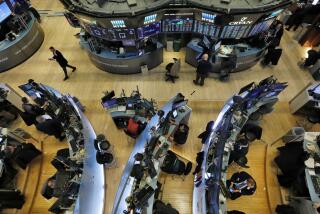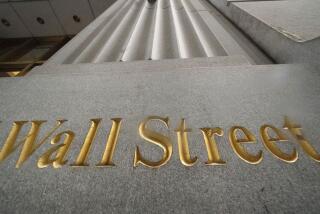Bull market rolls on as global financial markets overcome fears
- Share via
Global financial markets overcame a torrent of fears in 2012 to post strong gains nearly across the board.
Returns on most categories of stock mutual funds were in double digits. The average domestic equity fund generated a total return (price change plus dividend income) of 15%, after losing 2.5% in 2011, according to investment research firm Morningstar Inc.
It was the third calendar-year gain in the last four years, as the bull market that began in March 2009 rolled on.
Bond mutual funds also posted positive returns as market interest rates continued to slide, boosting the value of older bonds issued at higher rates.
Some of the year’s highlights:
•Shares of small and mid-size companies mostly outperformed blue-chip shares in the U.S. and abroad. Funds that own a blend of mid-size “growth” and “value” stocks rose 16.1%, on average, compared with a 14.9% advance for large-stock blend funds.
Typically, investors flock to smaller stocks when they’re bullish on economic growth. The rally that began last summer in most markets was fueled in large part by hopes of a pickup in global growth.
But central banks’ continued efforts to loosen credit also underpinned smaller shares, because many of those companies are dependent on lenders for financing. “I think it’s a vote of confidence in the credit markets,” said Jack Ablin, chief investment officer at BMO Private Bank in Chicago.
•The best-performing stock fund sector was global real estate — funds that own real estate investment trust shares, or REITs. The category surged 31.7% on average, according to Morningstar.
Global real estate funds were led by issues such as Westfield Group, the Australia-based mall operator, said Rob Wherry, an analyst at Morningstar. Many investors were hungry for funds that own “blue chip” properties worldwide, he said.
But the rally has driven down dividend yields on REITs, one of the sector’s traditional draws, Wherry said. “If you’re looking for a yield play now you want to look elsewhere,” he said. Or at least wait for a pullback.
•Foreign stock funds mostly beat domestic funds for the first time since 2009. The average European stock fund jumped 21% for the year. Emerging-market funds rose 18.5%.
The dollar’s decline against many foreign currencies last year helped boost overseas stock returns for U.S. investors, because stocks denominated in stronger currencies were worth more when translated into dollars.
•Technology-sector funds were relative laggards, gaining 13% on average. Despite another big year for shares of Apple Inc. — up 31% — tech funds were held back by weakness in Facebook Inc. and semiconductor shares and by another plunge in Hewlett-Packard Co., which sank 45% for the year.
•Precious metals funds were among the few losers. The funds, which typically own shares of gold and silver miners, slid 9.4% on average as gold’s price slumped late in the year. Demand for gold often wanes when investors turn more optimistic.
•Yield-starved investors continued to pour into bond funds, driving bond prices up and yields down. Emerging-market bond funds were stars, generating a total return of 17.8% on average. Investors also piled into high-yield junk bond funds and tax-free municipal issues.
Many investors fear a snap back in market yields at some point, which could devalue existing bonds. But with the Federal Reserve and other central banks keeping short-term interest rates near zero, that’s the equivalent of an anchor holding bond yields down.
More to Read
Inside the business of entertainment
The Wide Shot brings you news, analysis and insights on everything from streaming wars to production — and what it all means for the future.
You may occasionally receive promotional content from the Los Angeles Times.










